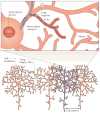Branching out: mechanisms of dendritic arborization
- PMID:20404840
- PMCID: PMC3079328
- DOI: 10.1038/nrn2836
Branching out: mechanisms of dendritic arborization
Erratum in
- Nat Rev Neurosci. 2010 Jun;11(6):449
Abstract
Type-specific dendrite morphology is a hallmark of the neuron and has important functional implications in determining what signals a neuron receives and how these signals are integrated. During the past two decades, studies on dendritic arborization neurons in Drosophila melanogaster have started to identify mechanisms of dendrite morphogenesis that may have broad applicability to vertebrate species. Transcription factors, receptor-ligand interactions, various signalling pathways, local translational machinery, cytoskeletal elements, Golgi outposts and endosomes have been identified as contributors to the organization of dendrites of individual neurons and the placement of these dendrites in the neuronal circuitry. Further insight into these mechanisms will improve our understanding of how the nervous system functions and might help to identify the underlying causes of some neurological and neurodevelopmental disorders.
Conflict of interest statement
The authors declare no competing financial interests.
Figures


References
- Ramon y Cayal S. In: Histology of the Nervous System of Man and Vertebrate. Swanson N, Swanson LW, translators. Oxford University Press; New York: 1995.
- Kaufmann WE, Moser HW. Dendritic anomalies in disorders associated with mental retardation. Cereb Cortex. 2000;10:981–991. - PubMed
- Kelleher RJ, III, Bear MF. The autistic neuron: troubled translation? Cell. 2008;135:401–406. - PubMed
Publication types
MeSH terms
Grants and funding
LinkOut - more resources
Full Text Sources
Molecular Biology Databases
Miscellaneous
